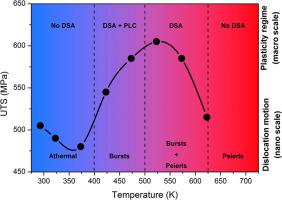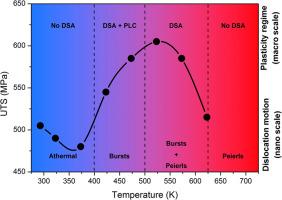锰对铁素体钢动态应变时效影响的研究。第二部分:工业合金
IF 9.3
1区 材料科学
Q1 MATERIALS SCIENCE, MULTIDISCIPLINARY
引用次数: 0
摘要
采用宏观拉伸试验、原位TEM拉伸试验和原子探针层析成像(APT)等方法,对焊接态C-Mn钢的动态应变时效(DSA)进行了研究。在宏观尺度上,与室温相比,DSA与423K至623K之间的极限拉伸强度(UTS)增加有关。在423K和473K的有限温度范围内观察PLC的锯齿。在纳米尺度上,DSA表现为位错动力学的变化,即位错爆发的发生。有趣的是,高温扩散控制(HTDC) peerls滑动抑制PLC的锯齿,其速度控制DSA的结束。此外,HTDC-Peierls滑移的发生表明,间隙原子控制了C-Mn焊缝中的DSA, HTDC-Peierls滑移的提取活化能和APT表征显示位错中没有Mn的存在证实了这一点。与本研究第一部分在Fe-3Mn-C模型中观察到的相反,Mn不影响工业C-Mn焊缝的DSA。我们认为,Mn含量的降低不会导致混合位错的充分锚定,从而导致HTDC-Peierls滑动的发生。因此,随着变形的进行,不吸引Mn原子的螺杆位错变得突出,从而抑制了Mn控制的DSA。基于这些发现,我们讨论了先前发表的关于DSA在钢中的表现作为其化学成分的函数的结果。本文章由计算机程序翻译,如有差异,请以英文原文为准。


Investigation of the influence of manganese on the dynamic strain ageing of ferritic steels – Part II: Industrial alloy
Dynamic strain aging (DSA) was studied in an as-welded C-Mn steel at multiple scales, using macroscopic tensile tests, in-situ TEM tensile tests and atom probe tomography (APT). At the macroscopic scale, DSA is related to an increase in Ultimate Tensile Strength (UTS) between 423 K and 623 K, compared to room temperature. PLC serrations are observed in a limited temperature range, 423 K and 473 K. At the nano-scale, DSA manifests as a change in dislocation dynamics, namely the occurrence of dislocation bursts. Interestingly, high-temperature diffusion-controlled (HTDC) Peierls glide suppresses PLC serrations, and its velocity controls the end of DSA. Moreover, the occurrence of HTDC-Peierls glide suggests that interstitial atoms control DSA in the C-Mn weld, that being confirmed by the extracted activation energy for HTDC-Peierls glide and by APT characterizations showing the absence of Mn on dislocations. Contrary to what was observed in the Fe-3Mn-C model in the first part of this study, Mn does not influence DSA in this industrial C-Mn weld. We propose that the reduced Mn content does not lead to a sufficient anchoring of mixed dislocations, thus allowing for the occurrence of HTDC-Peierls glide. Consequently, screw dislocations, which do not attract Mn atoms, become prominent as deformation proceeds, therefore suppressing the Mn-controlled DSA. Based on these findings, we discuss previously published results regarding the manifestations of DSA in steels as a function of their chemical composition.
求助全文
通过发布文献求助,成功后即可免费获取论文全文。
去求助
来源期刊

Acta Materialia
工程技术-材料科学:综合
CiteScore
16.10
自引率
8.50%
发文量
801
审稿时长
53 days
期刊介绍:
Acta Materialia serves as a platform for publishing full-length, original papers and commissioned overviews that contribute to a profound understanding of the correlation between the processing, structure, and properties of inorganic materials. The journal seeks papers with high impact potential or those that significantly propel the field forward. The scope includes the atomic and molecular arrangements, chemical and electronic structures, and microstructure of materials, focusing on their mechanical or functional behavior across all length scales, including nanostructures.
 求助内容:
求助内容: 应助结果提醒方式:
应助结果提醒方式:


